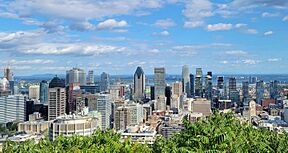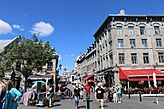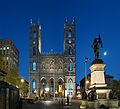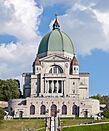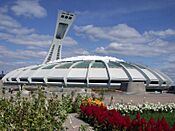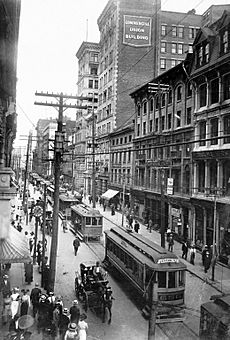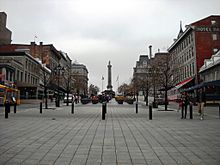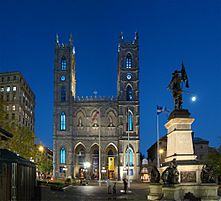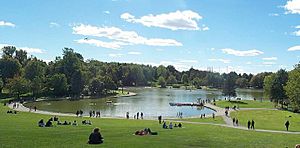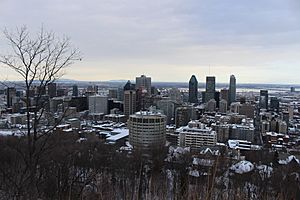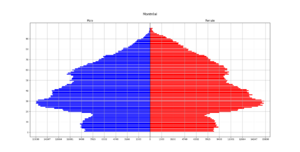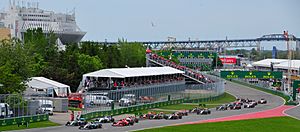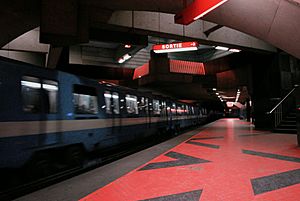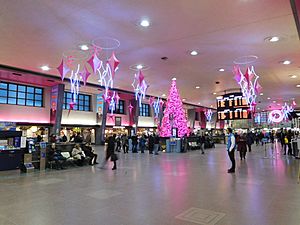Montreal facts for kids
Quick facts for kids
Montreal
Montréal (French)
|
|||||
|---|---|---|---|---|---|
| Ville de Montréal (French) | |||||
|
|||||
| Nicknames:
"MTL", "The 514", "The City of Festivals", "The City of Saints", "The City of a Hundred Steeples", "Sin City", "La Métropole"
|
|||||
| Motto(s):
Concordia Salus ("well-being through harmony")
|
|||||
| Country | Canada | ||||
| Province | Quebec | ||||
| Region | Montreal | ||||
| Urban agglomeration | Montreal | ||||
| Founded | May 17, 1642 | ||||
| Incorporated | 1832 | ||||
| Constituted | January 1, 2002 | ||||
| Named for | Mount Royal | ||||
| Boroughs |
List
Ahuntsic-Cartierville
Anjou Côte-des-Neiges–Notre-Dame-de-Grâce L'Île-Bizard–Sainte-Geneviève LaSalle Lachine Le Plateau-Mont-Royal Le Sud-Ouest Mercier–Hochelaga-Maisonneuve Montréal-Nord Outremont Pierrefonds-Roxboro Rivière-des-Prairies–Pointe-aux-Trembles Rosemont–La Petite-Patrie Saint-Laurent Saint-Léonard Verdun Ville-Marie Villeray–Saint-Michel–Parc-Extension |
||||
| Government | |||||
| • Type | Montreal City Council | ||||
| Area | |||||
| • City | 431.50 km2 (166.60 sq mi) | ||||
| • Land | 365.13 km2 (140.98 sq mi) | ||||
| • Urban | 1,293.99 km2 (499.61 sq mi) | ||||
| • Metro | 4,604.26 km2 (1,777.71 sq mi) | ||||
| Highest elevation | 233 m (764 ft) | ||||
| Lowest elevation | 6 m (20 ft) | ||||
| Population
(2024)
|
|||||
| • City | 1,895,211 (2nd) | ||||
| • Density | 4,828.3/km2 (12,505/sq mi) | ||||
| • Metro | 4,291,732 (2nd) | ||||
| • Metro density | 919/km2 (2,380/sq mi) | ||||
| Demonyms | Montrealer Montréalais(e) |
||||
| Time zone | UTC−05:00 (EST) | ||||
| • Summer (DST) | UTC−04:00 (EDT) | ||||
| Postal codes |
H
H1A, H1C-H3N, H3S-H3W, H4A-H4T, H4Z-H5B, H8R-H8Z, H9C-H9E, H9H, H9K
|
||||
| Area codes | 514, 438 and 263 | ||||
| Police | SPVM | ||||
| GDP (Montreal CMA) | CA$228.71 billion (2020) | ||||
| GDP per capita (Montreal CMA) | CA$48,289 (2022) | ||||
Montreal is the largest city in the Canadian province of Quebec. It is also the second-largest city in Canada and the ninth-largest in North America. The city was founded in 1642 as Ville-Marie, which means "City of Mary". Today, it is named after Mount Royal, a triple-peaked hill in the heart of the city.
Montreal is located on the Island of Montreal and some smaller islands nearby. The city is about 196 kilometers (122 miles) east of Ottawa, Canada's capital. It is also 258 kilometers (160 miles) southwest of Quebec City, the capital of Quebec.
As of 2021, Montreal had a population of over 1.7 million people. Its larger metropolitan area had more than 4.2 million people. This makes it the second-largest metropolitan area in Canada. French is the official language of the city. Most people in Montreal can speak French, and many can speak both French and English. This makes Montreal one of the most bilingual cities in Canada.
Montreal used to be the main business center of Canada. However, Toronto grew larger in population and economy in the 1970s. Still, Montreal is very important for art, culture, movies, music, business, and technology. It is also a UNESCO City of Design. Montreal is often ranked as one of the best cities for university students.
Montreal has hosted many big international events. These include the 1967 World's Fair and the 1976 Summer Olympics. It is the only Canadian city to have hosted the Summer Olympics. The city also hosts the Canadian Grand Prix for Formula One racing. It is home to the Montreal International Jazz Festival, the world's largest jazz festival. The Just for Laughs festival, the biggest comedy festival, is also held here. In sports, Montreal has professional teams like the Montreal Canadiens hockey team. They have won the Stanley Cup a record 24 times.
Contents
- How Montreal Got Its Name
- A Look at Montreal's Past
- Where Montreal Is Located
- Montreal's Buildings and Design
- Exploring Montreal's Neighborhoods
- Who Lives in Montreal?
- Montreal's Economy and Jobs
- Montreal's Culture and Arts
- Sports in Montreal
- Media and News in Montreal
- Education in Montreal
- Getting Around Montreal
- International Connections
- Images for kids
- See Also
How Montreal Got Its Name
Early Names from Indigenous Peoples
The land where Montreal now stands has ancient names from Indigenous languages. In the Ojibwe language, it is called Mooniyaang or Moon’yaang. This means "the first stopping place" in their migration stories.
In the Mohawk language, the land is known as Tiohtià:ke. This name comes from a longer word meaning "where the group divided or parted ways."
French Settlers and Mount Royal
French settlers founded their new town in 1642. They first called it Ville Marie, which means "City of Mary". They named it after the Virgin Mary.
The name Montréal comes from Mount Royal. This is the triple-peaked hill in the middle of the city. In the 1500s, the French words réal and royal were used in the same way. So, Montréal might just be another way to say Mont Royal.
Some people thought the name came from an Italian mapmaker, Giovanni Battista Ramusio. He used the name Monte Real for Mount Royal in 1556. However, Quebec's naming commission does not agree with this idea. The first time Montréal was used for the whole area was in 1575.
A Look at Montreal's Past
First Peoples on the Island
Long before Europeans arrived, Indigenous people lived on the island of Montreal. Archaeological findings show they were here as early as 4,000 years ago. By the year 1000 AD, they started growing maize (corn).
A few centuries later, they built fortified villages. The St. Lawrence Iroquoians built the village of Hochelaga at the foot of Mount Royal. This was about 200 years before the French came. French explorer Jacques Cartier visited Hochelaga in 1535. He thought over a thousand people lived there.
Early French Settlements
By 1611, French explorer Samuel de Champlain set up a fur trading post on the Island of Montreal. He called this spot La Place Royale. In 1639, a man named Jérôme Le Royer de La Dauversière got the rights to the island. He wanted to create a mission to teach Christianity to the Indigenous people.
In 1642, a group of colonists led by Paul Chomedey de Maisonneuve founded Ville-Marie. This settlement included a chapel and a hospital. The Iroquois people attacked Ville-Marie often. By 1652, there were only about 50 people left. Maisonneuve had to go back to France to find 100 more volunteers to save the colony.
By 1685, Ville-Marie had about 600 colonists. It became a center for the fur trade and a base for more exploration. In 1689, the Iroquois attacked Lachine, causing a terrible event. The area was a French colony until 1760. Then, it became part of Great Britain after the Seven Years' War. The name Montreal started appearing in official documents around 1705.
Modern Growth and Changes
Montreal officially became a city in 1832. The Lachine Canal opened, letting ships avoid difficult parts of the river. The Victoria Bridge made Montreal a major railway center. By 1860, it was the largest city in British North America. It was also the main economic and cultural hub of Canada.
In the 1800s, Montreal's population grew quickly. Getting clean drinking water became a challenge. In the 1840s, the city built a system to pump water from the St. Lawrence River. This water went into large tanks that were then taken to different places.
Montreal was the capital of the Province of Canada from 1844 to 1849. It lost this status when a crowd burned down the Parliament building. Queen Victoria chose Ottawa as the new capital. Ottawa was safer from attacks and was a good compromise between French and English Canada.
After World War I, the United States had a ban on alcohol. This made Montreal a popular place for Americans to find alcoholic drinks. However, the Great Depression in the 1930s caused high unemployment in the city.
During World War II, Mayor Camillien Houde was against conscription (forced military service). He told Montrealers not to register for the war effort. The government arrested him and held him until 1944.
By 1951, Montreal's population reached over one million. But Toronto started to grow faster. The Saint Lawrence Seaway opened in 1959. This allowed ships to bypass Montreal, which affected the city's business leadership. In the 1960s, Montreal continued to grow. It hosted the World's Fair and built new skyscrapers and the Montreal Metro subway system.
The 1970s brought big changes. French-speaking people wanted to protect their language and culture. In 1976, Montreal hosted the 1976 Summer Olympics. Later, some businesses and people left the city due to political changes. During the 1980s and early 1990s, Montreal's economy grew slower than other big Canadian cities.
In 2002, Montreal merged with 27 nearby towns on the island. This created one large city. But many people in the suburbs didn't like this. In 2006, some of these towns voted to separate from Montreal. They still work together on some services.
The 21st century has seen Montreal's economy and culture grow again. New buildings, hospitals, and public spaces have been built. The city is also improving its transportation with new bridges and subway lines.
Where Montreal Is Located
City Layout and Features
Montreal is in the southwest part of Quebec. The city covers most of the Island of Montreal. This island is where the Saint Lawrence and Ottawa Rivers meet. The Port of Montreal is at one end of the Saint Lawrence Seaway. This waterway connects the Great Lakes to the Atlantic Ocean.
The city is named after its most important natural feature, Mount Royal. This hill has three peaks and is 232 meters (761 feet) above sea level. Montreal is surrounded by the Saint Lawrence River to the south and the Rivière des Prairies to the north.
Montreal is the center of the Montreal Metropolitan Community. To the north, it borders the city of Laval. To the south, it borders cities like Longueuil and Brossard. There are also smaller English-speaking towns like Westmount and Town of Mount Royal that are surrounded by Montreal.
Montreal's Weather and Seasons
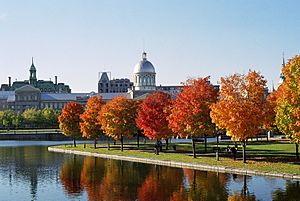
Montreal has a humid continental climate. This means it has warm summers and cold, snowy winters.
Summers are usually warm and humid. The average high temperature in July is about 26 to 27 °C (79 to 81 °F). Temperatures can often go above 30 °C (86 °F).
Winters are cold, snowy, and windy. The average daily temperature in January is about -9 to -10.5 °C (13 to 17 °F). Sometimes, the temperature can rise above freezing, bringing rain. Snow usually covers the ground from early December to late March. The lowest temperature ever recorded was -37.8 °C (-36 °F) in 1957. The highest was 37.6 °C (99.7 °F) in 1975.
Spring and fall are mild but can have sudden temperature changes. Snowstorms can happen in November and March, and sometimes even in April. Montreal usually has no snow from April 15 to November 15.
The city gets about 1000 mm (39 inches) of rain each year. It also gets about 210 cm (83 inches) of snowfall from November to March. Thunderstorms are common from late spring to early fall. Montreal gets about 2,050 hours of sunshine each year. Summer is the sunniest season.
| Climate data for McGill University (McTavish), 1971–2000 normals, extremes 1871–present | |||||||||||||
|---|---|---|---|---|---|---|---|---|---|---|---|---|---|
| Month | Jan | Feb | Mar | Apr | May | Jun | Jul | Aug | Sep | Oct | Nov | Dec | Year |
| Record high °C (°F) | 12.8 (55.0) |
15.0 (59.0) |
25.9 (78.6) |
30.1 (86.2) |
34.2 (93.6) |
34.5 (94.1) |
36.1 (97.0) |
35.6 (96.1) |
33.5 (92.3) |
28.9 (84.0) |
22.2 (72.0) |
17.0 (62.6) |
36.1 (97.0) |
| Mean daily maximum °C (°F) | −5.4 (22.3) |
−3.7 (25.3) |
2.4 (36.3) |
11.0 (51.8) |
19.0 (66.2) |
23.7 (74.7) |
26.6 (79.9) |
24.8 (76.6) |
19.4 (66.9) |
12.3 (54.1) |
5.1 (41.2) |
−2.3 (27.9) |
11.1 (52.0) |
| Daily mean °C (°F) | −8.9 (16.0) |
−7.2 (19.0) |
−1.2 (29.8) |
7.0 (44.6) |
14.5 (58.1) |
19.3 (66.7) |
22.3 (72.1) |
20.8 (69.4) |
15.7 (60.3) |
9.2 (48.6) |
2.5 (36.5) |
−5.6 (21.9) |
7.4 (45.3) |
| Mean daily minimum °C (°F) | −12.4 (9.7) |
−10.6 (12.9) |
−4.8 (23.4) |
2.9 (37.2) |
10.0 (50.0) |
14.9 (58.8) |
17.9 (64.2) |
16.7 (62.1) |
11.9 (53.4) |
5.9 (42.6) |
−0.2 (31.6) |
−8.9 (16.0) |
3.6 (38.5) |
| Record low °C (°F) | −33.5 (−28.3) |
−33.3 (−27.9) |
−28.9 (−20.0) |
−17.8 (0.0) |
−5 (23) |
1.1 (34.0) |
7.8 (46.0) |
6.1 (43.0) |
0.0 (32.0) |
−7.2 (19.0) |
−27.8 (−18.0) |
−33.9 (−29.0) |
−33.9 (−29.0) |
| Average precipitation mm (inches) | 73.6 (2.90) |
70.9 (2.79) |
80.2 (3.16) |
76.9 (3.03) |
86.5 (3.41) |
87.5 (3.44) |
106.2 (4.18) |
100.6 (3.96) |
100.8 (3.97) |
84.3 (3.32) |
93.6 (3.69) |
101.5 (4.00) |
1,062.5 (41.83) |
| Average rainfall mm (inches) | 28.4 (1.12) |
22.7 (0.89) |
42.2 (1.66) |
65.2 (2.57) |
86.5 (3.41) |
87.5 (3.44) |
106.2 (4.18) |
100.6 (3.96) |
100.8 (3.97) |
82.1 (3.23) |
68.9 (2.71) |
44.4 (1.75) |
834.9 (32.87) |
| Average snowfall cm (inches) | 45.9 (18.1) |
46.6 (18.3) |
36.8 (14.5) |
11.8 (4.6) |
0.4 (0.2) |
0.0 (0.0) |
0.0 (0.0) |
0.0 (0.0) |
0.0 (0.0) |
2.2 (0.9) |
24.9 (9.8) |
57.8 (22.8) |
226.2 (89.1) |
| Average precipitation days (≥ 0.2 mm) | 15.8 | 12.8 | 13.6 | 12.5 | 12.9 | 13.8 | 12.3 | 13.4 | 12.7 | 13.1 | 15.0 | 16.2 | 163.9 |
| Average rainy days (≥ 0.2 mm) | 4.3 | 4.0 | 7.4 | 10.9 | 12.8 | 13.8 | 12.3 | 13.4 | 12.7 | 12.7 | 11.5 | 6.5 | 122.2 |
| Average snowy days (≥ 0.2 cm) | 13.6 | 11.1 | 8.3 | 3.0 | 0.14 | 0.0 | 0.0 | 0.0 | 0.0 | 0.62 | 5.3 | 12.0 | 53.9 |
| Mean monthly sunshine hours | 99.2 | 119.5 | 158.8 | 181.7 | 229.8 | 250.1 | 271.6 | 230.7 | 174.1 | 138.6 | 80.4 | 80.7 | 2,015.2 |
| Source: Environment Canada | |||||||||||||
Montreal's Buildings and Design
Historic and Modern Architecture
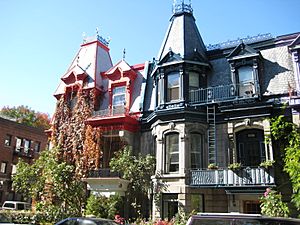
For over 150 years, Montreal was a major industrial and financial center in Canada. This history left behind many interesting buildings. These include old factories, elevators, and warehouses. They offer a great look into the city's past, especially in downtown and the Old Port. Montreal has 50 National Historic Sites of Canada, more than any other city.
Some of the oldest buildings still standing date back to the late 1600s. Many are in the Old Montreal area. The Sulpician Seminary, built in 1687, is next to the Notre Dame Basilica. The Château Ramezay was built in 1705. The Le Ber-Le Moyne House in Lachine is the oldest complete building in the city. The Maison Saint-Gabriel in Point St. Charles dates back to 1698.
Many historic buildings in Old Montreal look as they did originally. These include the Notre Dame of Montreal Basilica, Bonsecours Market, and old bank headquarters on Saint Jacques Street. Montreal's early buildings are known for their French style and grey stone.
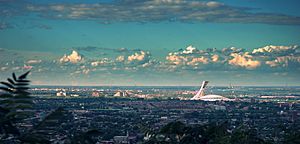
Later, in the 20th century, new famous buildings appeared. These include Saint Joseph's Oratory, the main building of Université de Montréal, and the Place Ville Marie office tower. The Olympic Stadium is another well-known example. Many buildings designed for Expo 67 in 1967 also became landmarks. These include Buckminster Fuller's geodesic dome (now the Montreal Biosphere) and Moshe Safdie's Habitat 67 apartments.
The Montreal Metro subway system also features public artwork by famous Quebec artists.
A City of Design
In 2006, UNESCO named Montreal a City of Design. It was one of only three cities in the world to get this title. This award recognizes Montreal's strong design community. The city is home to important international design organizations.
Montreal also has an Underground City, officially called RESO. This is a popular tourist spot. It is a network of connected shopping areas, both above and below ground. This network links pedestrian walkways to universities, hotels, restaurants, and subway stations. It has 32 kilometers (20 miles) of tunnels under 12 square kilometers (4.6 square miles) of downtown Montreal.
Exploring Montreal's Neighborhoods
Diverse Areas of the City
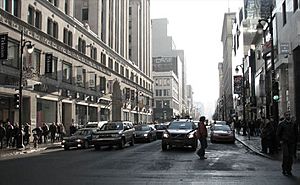

Montreal is divided into 19 large boroughs. These boroughs are then split into smaller neighborhoods.
Some central boroughs include Côte-des-Neiges–Notre-Dame-de-Grâce, The Plateau Mount Royal, Outremont, and Ville Marie. Other boroughs are in the east, northeast, northwest, and south of the city.
Many of these boroughs used to be independent cities. They were merged with Montreal in 2002. However, some voted to separate again in 2006. These separated towns still work with Montreal on many shared services.
The borough of Ville Marie has the most neighborhoods. It includes downtown, the historic Old Montreal, and Chinatown. It also has the Gay Village, the Latin Quarter, and the developing Quartier des Spectacles. The wealthy Golden Square Mile neighborhood is at the foot of Mount Royal. The Shaughnessy Village area is home to many students from Concordia University. This borough also includes most of Mount Royal Park, Saint Helen's Island, and Notre-Dame Island.
The Plateau Mount Royal borough was once a working-class French-speaking area. The largest neighborhood, also called the Plateau, is becoming more modern. It is known for having many artists. The Mile End neighborhood is very multicultural. It has two famous bagel shops, St-Viateur Bagel and Fairmount Bagel. The McGill Ghetto is home to many students and teachers from McGill University.
The South West borough used to be a major industrial area. It includes historic Irish neighborhoods like Griffintown and Point Saint Charles. It also has working-class areas like Saint Henri and Little Burgundy.
Other interesting neighborhoods include the multicultural areas of Notre-Dame-de-Grâce and Côte-des-Neiges. Little Italy is in the Rosemont–La Petite-Patrie borough. Hochelaga-Maisonneuve is home to the Olympic Stadium.
Discovering Old Montreal
Old Montreal is a historic area southeast of downtown. It has many popular attractions. These include the Old Port of Montreal, Place Jacques-Cartier, and Montreal City Hall. You can also find the Bonsecours Market, Place d'Armes, and the Pointe-à-Callière Museum. The beautiful Notre-Dame de Montréal Basilica is also here.
The buildings and cobbled streets in Old Montreal have been kept or restored. Tourists often ride in horse-drawn buggies through the area. You can reach Old Montreal from downtown through the underground city. It also has bus routes, Metro stations, and bicycle paths.
The area next to Old Montreal along the river is called the Old Port. This used to be where the Port of Montreal operated. Now, shipping has moved downstream, and the Old Port is a fun historical and recreational area. The new Port of Montreal is Canada's largest container port.
Exploring Mount Royal Park
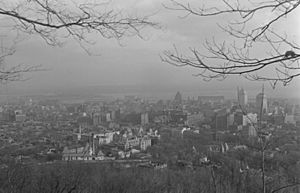
Mount Royal is the mountain that gives Montreal its name. It is home to Mount Royal Park, one of the city's largest green spaces. Frederick Law Olmsted, who designed New York's Central Park, designed this park. It opened in 1876.
The park has two viewpoints, called belvederes. The Kondiaronk Belvedere has a semicircular plaza and a chalet. It offers amazing views of Downtown Montreal. Other parts of the park include Beaver Lake, a small man-made lake, and a short ski slope. There is also a sculpture garden and a visitor center. The park hosts many sports, tourist, and cultural events.
The mountain also has two large cemeteries: Notre-Dame-des-Neiges (from 1854) and Mount Royal (from 1852). Mount Royal Cemetery is a 165-acre terraced cemetery. Notre Dame des Neiges Cemetery is much larger and is mainly for French-Canadians. Over 900,000 people are buried there.
The first cross on the mountain was placed there in 1643. Paul Chomedey de Maisonneuve, the city's founder, put it there. He had promised to do so if the Virgin Mary helped stop a big flood. Today, a 31.4-meter (103-foot) tall illuminated cross stands on the mountain. It was put up in 1924 and now uses fiber optic lights. The lights can change color, like red, blue, or purple. Purple is used to show mourning, for example, after the death of a Pope.
Who Lives in Montreal?
Population and Languages
| Population history of Montreal | ||
|---|---|---|
| Year | Pop. | ±% |
| 1666 | 625 | — |
| 1667 | 760 | +21.6% |
| 1681 | 1,418 | +86.6% |
| 1685 | 724 | −48.9% |
| 1688 | 1,360 | +87.8% |
| 1692 | 801 | −41.1% |
| 1695 | 1,468 | +83.3% |
| 1698 | 1,185 | −19.3% |
| 1706 | 2,025 | +70.9% |
| 1739 | 4,210 | +107.9% |
| 1754 | 4,000 | −5.0% |
| 1765 | 5,733 | +43.3% |
| 1790 | 18,000 | +214.0% |
| 1825 | 31,516 | +75.1% |
| 1831 | 27,297 | −13.4% |
| 1841 | 40,356 | +47.8% |
| 1851 | 57,715 | +43.0% |
| 1861 | 90,323 | +56.5% |
| 1871 | 130,022 | +44.0% |
| 1881 | 176,263 | +35.6% |
| 1891 | 254,278 | +44.3% |
| 1901 | 325,653 | +28.1% |
| 1911 | 490,504 | +50.6% |
| 1921 | 618,506 | +26.1% |
| 1931 | 818,577 | +32.3% |
| 1941 | 903,007 | +10.3% |
| 1951 | 1,021,520 | +13.1% |
| 1961 | 1,201,559 | +17.6% |
| 1971 | 1,214,352 | +1.1% |
| 1976 | 1,080,545 | −11.0% |
| 1981 | 1,018,609 | −5.7% |
| 1986 | 1,015,420 | −0.3% |
| 1991 | 1,017,666 | +0.2% |
| 1996 | 1,016,376 | −0.1% |
| 2001 | 1,039,534 | +2.3% |
| 2006 | 1,620,693 | +55.9% |
| 2011 | 1,649,519 | +1.8% |
| 2016 | 1,704,694 | +3.3% |
| 2021 | 1,762,949 | +3.4% |
| Note: Many boroughs were independent cities that were forced to merge with Montreal in January 2002 following the 2002 municipal reorganization of Montreal. | ||
In the 2021 Census, Montreal had a population of 1,762,949 people. This was a 3.4% increase from 2016. The larger Montreal metropolitan area had 4,291,732 people in 2021.
Most people in Montreal have European backgrounds. In the 2006 census, the largest groups were French (23%), Italians (10%), and Irish (5%).
In 2021, about 60% of Montreal's population was of European background. Other large groups included African (11.5%), Middle Eastern (9.3%), and South Asian (4.6%). About 38.8% of the city's population were visible minorities in 2021.
Languages Spoken in Montreal
Montreal is known for its many languages. In 2006, about 66.5% of people in the Greater Montreal Area spoke French as their first language. About 13.2% spoke English first. Another 0.8% spoke both French and English as their first language.
The remaining 22.5% spoke other languages. These include Italian, Arabic, Spanish, Chinese, and Greek. Many people in Montreal can speak both French and English. This is a special feature of the city compared to other Canadian cities.
Immigrants and Religions
In 2021, about 33.4% of Montreal's population were immigrants. This means they were born outside Canada. The top countries of origin for immigrants were Haiti, Algeria, France, and Morocco.
| Religion in Montreal (2021) | ||||
|---|---|---|---|---|
| Religion | Percent (%) | |||
| Christian | 49.5% | |||
| No religion | 31.0% | |||
| Muslim | 12.7% | |||
| Jewish | 2.1% | |||
| Hindu | 1.8% | |||
| Buddhist | 1.5% | |||
| Sikh | 0.9% | |||
| Other | 0.5% | |||
The Greater Montreal Area is mostly Catholic. About 49.5% of the population is Christian, with 35% being Roman Catholic. This is mainly due to descendants of early French settlers, as well as Italian and Irish immigrants.
Islam is the largest non-Christian religion, with 12.7% of the population. Montreal has the second-largest number of Muslims in Canada. The Jewish community in Montreal has about 90,780 members. In some areas like Côte Saint-Luc, Jewish people make up a large part of the population.
Montreal's Economy and Jobs
A Strong Business Center
Montreal has the second-largest economy among Canadian cities. It is the largest in Quebec. In 2019, the Montreal area contributed about $234 billion CAD to Quebec's economy. Today, Montreal is an important center for business, finance, technology, and culture. It is also home to the Montreal Exchange, a stock exchange.
Industries in Montreal include aerospace, electronic goods, and pharmaceuticals. Other important areas are software engineering, telecommunications, and transportation. The service sector is also strong, including finance and higher education. In 2002, Montreal had the fourth-highest number of aerospace jobs in North America.
The Port of Montreal is one of the largest inland ports in the world. It handles millions of tons of cargo each year. It is a key point for shipping grain, sugar, and other goods. Montreal is also a major railway hub in Canada. It is home to the headquarters of the Canadian National Railway.
Global Connections and Creativity
The Canadian Space Agency headquarters is near Montreal. Montreal also hosts the headquarters of several international organizations. These include the International Civil Aviation Organization (ICAO), a United Nations body, and the World Anti-Doping Agency.
Montreal is a big center for film and television. The National Film Board of Canada has five studios here. The city also hosts many famous cultural, film, and music festivals. These include Just For Laughs and the Montreal International Jazz Festival. These festivals bring a lot of money to the city. Montreal is also home to the Cirque du Soleil, a world-famous entertainment company.
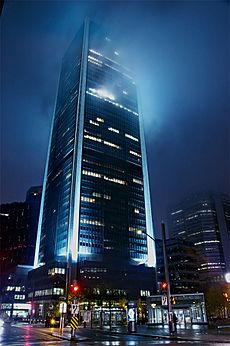
Montreal is a global hub for artificial intelligence (AI) research. Many major tech companies have AI research labs here. These include Facebook AI Research (FAIR) and Google Brain. The city is also home to Mila (research institute), one of the largest AI research institutes in the world.
The video game industry is growing fast in Montreal. Many leading game developers like Ubisoft Montreal and EA have studios here. This is because of the skilled local workers and tax benefits. In 2010, Warner Bros. Interactive Entertainment opened a studio in Montreal.
Montreal also plays a big role in the finance industry. It is ranked among the top financial centers in the world. The city is home to the Montreal Exchange, Canada's oldest stock exchange. While some big banks moved their main offices, their legal offices are still in Montreal. Two smaller Canadian banks, National Bank of Canada and Laurentian Bank of Canada, have their headquarters here.
Many large companies have their main offices in the Montreal area. These include Rio Tinto Alcan, Bombardier Inc., Air Canada, and Cirque du Soleil. The Montreal Oil Refining Centre is the largest refining center in Canada.
Montreal's Culture and Arts
A City of Festivals and Creativity
Monocle magazine called Montreal "Canada's Cultural Capital". It is the main center for French-language TV, radio, theater, and film in Canada. Montreal's many different communities have created a unique local culture. In 2005, UNESCO named Montreal the World Book Capital.
Montreal mixes French and English traditions, giving it a special cultural identity. The city has produced many talented artists in visual arts, theater, dance, and music. It is known for both jazz and rock music. Downtown Montreal is very lively, especially in summer. This is because of its many cultural events and over 100 annual festivals.
The Montreal International Jazz Festival is the largest jazz festival in the world. Other popular events include Just for Laughs, the biggest comedy festival. There is also the Montreal World Film Festival and Les Francos de Montréal, a large French-language music festival. These festivals add a lot to the city's culture and economy. Montreal is also famous for its lively nightlife.
The Place des Arts is a cultural hub for classical art and summer festivals. It has many concert and theater halls around a big square downtown. The Montreal Symphony Orchestra, one of the world's best orchestras, is based here. The Opéra de Montréal and the ballet company Les Grands Ballets Canadiens also perform at Place des Arts.
Churches and Literature

Montreal is nicknamed la ville aux cent clochers, meaning "the city of a hundred steeples". This is because it has so many churches. There are about 650 churches on the island, with 450 of them built before the 1800s. Mark Twain once said, "This is the first time I was ever in a city where you couldn't throw a brick without breaking a church window."
The city has four Roman Catholic basilicas: Mary, Queen of the World Cathedral, Notre-Dame Basilica, St Patrick's Basilica, and Saint Joseph's Oratory. The Oratory is the largest church in Canada. Its copper dome is the second largest in the world, after Saint Peter's Basilica in Rome.
Starting in the 1940s, Quebec literature began to focus on Montreal's multicultural city life. Famous books like Gabrielle Roy's The Tin Flute and Gwethalyn Graham's Earth and High Heaven describe the city's unique character. Many other writers have also set their stories in Montreal.
Sports in Montreal
Popular Teams and Events
The most popular sport in Montreal is ice hockey. The professional hockey team, the Montreal Canadiens, is one of the Original Six teams in the National Hockey League (NHL). They have won a record 24 Stanley Cup championships. Their last win was in 1993. The Canadiens have big rivalries with the Toronto Maple Leafs and Boston Bruins. They play their games at the Bell Centre.
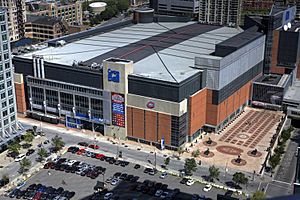
The Montreal Alouettes are the city's Canadian Football League (CFL) team. They play at Percival Molson Memorial Stadium. They have won the Grey Cup eight times, most recently in 2023.
Montreal has a rich baseball history. The city was home to the minor-league Montreal Royals until 1960. In 1946, Jackie Robinson played for the Royals, breaking the Baseball colour line. Major League Baseball came to Montreal in 1969 with the Montreal Expos. They played at Jarry Park Stadium and later at Olympic Stadium. In 2005, the team moved to Washington, D.C.
CF Montréal (formerly Montreal Impact) is the city's professional soccer team. They play at Saputo Stadium. They joined Major League Soccer in 2012. Olympic Stadium has also hosted major soccer games, including for the 2015 FIFA Women's World Cup.
Montreal hosts a big auto racing event every year: the Canadian Grand Prix for Formula One (F1) racing. This race takes place on the Circuit Gilles Villeneuve on Île Notre-Dame.
Uniprix Stadium is used for the National Bank Open tennis tournaments. The men's and women's tournaments switch between Montreal and Toronto each year.
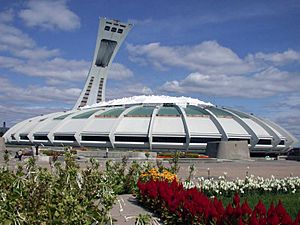
Montreal hosted the 1976 Summer Olympics. The Olympic Stadium cost a lot of money to build, but it was finally paid off in 2006. Montreal also hosted the first World Outgames in 2006, with over 16,000 participants.
| Club | League | Sport | Venue | Established | Championships |
|---|---|---|---|---|---|
| Montreal Canadiens | NHL | Ice hockey | Bell Centre | 1909 | 24 |
| Montréal Alouettes | CFL | Canadian football | Percival Molson Memorial Stadium | 1946 | 8 |
| CF Montréal | MLS | Soccer | Saputo Stadium | 2012 | 0 |
| Montreal Alliance | CEBL | Basketball | Verdun Auditorium | 2022 | 0 |
| Montreal Victoire | PWHL | Ice hockey | Place Bell | 2023 | 0 |
| Montreal Roses FC | NSL | Soccer | TBA | 2023 | 0 |
Media and News in Montreal
Montreal is Canada's second-largest media market. It is the center of Canada's French-speaking media industry.
There are several English-language TV stations, including CBMT-DT (CBC), CFCF-DT (CTV), and CKMI-DT (Global). There are also many French-language TV stations, such as CBFT-DT (Ici Radio-Canada) and CFTM-DT (TVA).
Montreal has three daily newspapers. The English one is Montreal Gazette. The French ones are Le Journal de Montréal and Le Devoir. Another French daily, La Presse, became an online-only newspaper in 2018. There are also free French daily newspapers. Many weekly newspapers serve different neighborhoods and groups.
Education in Montreal
School System and Universities
The education system in Quebec is a bit different from other places in North America. After high school (which finishes at grade 11), students go to a special school called CEGEP. CEGEPs offer two-year programs before university or three-year technical programs. In Montreal, 17 CEGEPs teach in French, and five teach in English.
Public elementary and secondary schools in Montreal are run by different school boards. There are French-language boards and English-language boards.
Montreal has a very high number of college and university students. It has four universities, ten other degree-granting schools, and 12 CEGEPs close together. This means it has more post-secondary students per resident than almost any other major city in North America.
English-Speaking Universities

- McGill University is one of Canada's top universities. It is known worldwide for its quality. In 2021, McGill was ranked the best medical-doctoral university in Canada for the 17th year in a row. It was also ranked the 27th best university in the world.
- Concordia University was formed in 1974 by combining two colleges. It is ranked as one of the top comprehensive universities in Canada.
French-Speaking Universities
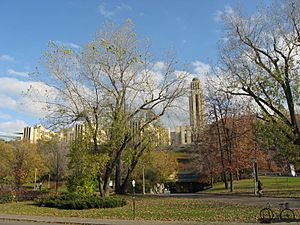
- Université de Montréal (UdeM) is the second-largest research university in Canada. It is considered one of the top universities in the country. Two other schools are part of UdeM: the École Polytechnique Montréal (an engineering school) and HEC Montréal (a business school). HEC Montreal is one of the best business schools in Canada.
- Université du Québec à Montréal (UQAM) is the Montreal campus of the Université du Québec network. UQAM focuses on liberal arts but also has science programs.
- The Université du Québec network also has other schools in Montreal. These include the École de technologie supérieure (ETS) for technology and the École nationale d'administration publique (ÉNAP) for public administration.
Getting Around Montreal
Roads and Bridges
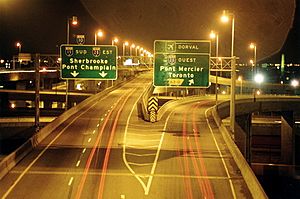
Like many big cities, Montreal has traffic problems. Many people drive into the city from nearby towns. It's hard and expensive to build bridges across the wide Saint Lawrence River. There are currently four road bridges, one bridge-tunnel, two railway bridges, and a subway line connecting to the south shore. To the north, nine road bridges and a Metro line cross the narrower Rivière des Prairies to Laval.
The island of Montreal is a central point for Quebec's Autoroute (highway) system. Many of these highways, like A-10, A-15, A-20, A-25, and A-40, get very busy during rush hour. The government is working on solutions, like extending Autoroute 30 to create a bypass for trucks.
Public Transportation
Public transport in Montreal includes buses, subways, and commuter trains. The STM (Société de transport de Montréal) runs the bus and subway system. The STM bus network has over 200 daytime routes and 23 night routes. In 2010, STM buses served over 1.3 million passengers on an average weekday. The STM also has wheelchair-accessible buses. In 2010, the STM won an award for being the best public transit system in North America.
The Montreal Metro subway system opened in 1966. It has 68 stations on four lines. On an average weekday, over 1 million people use the Metro. Each station has a unique design and original artwork. The trains run on rubber tires, which makes them quieter. The Metro was started by Montreal Mayor Jean Drapeau, who also brought the Summer Olympics to the city. The Metro has a station in Longueuil on the South Shore. In 2007, it was extended to Laval to the north. The Metro is also getting new, modern trains with connected cars.
Air and Rail Travel
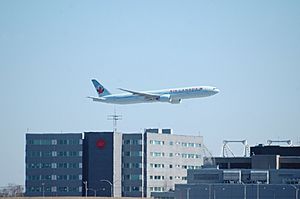
Montreal has two international airports. Pierre Elliott Trudeau International Airport (Dorval Airport) handles all passenger flights. It is also the headquarters for Air Canada and Air Transat. To the north, Montreal Mirabel International Airport now mainly handles cargo flights. In 2018, Trudeau Airport was the third busiest airport in Canada. It handles flights to 155 destinations on five continents.
Montreal-based Via Rail Canada provides train service to other Canadian cities. These include Quebec City and Toronto. Amtrak, the U.S. passenger rail system, runs a daily train to New York. Most intercity and commuter trains use Central Station.
The Canadian Pacific Railway (CPR) was founded in Montreal in 1881. Its headquarters were in Windsor Station until 1995. Montreal is still an important rail city, connecting to many other lines.
The commuter rail system is managed by Exo. It reaches the areas around Greater Montreal with six lines. In 2014, it carried about 79,000 passengers daily.
A new automated subway system, the Réseau express métropolitain (REM), is being built. It will be 67 kilometers (42 miles) long with 26 stations. Construction started in 2018 and is expected to finish by mid-2024. The REM will be one of the largest automated transit networks in the world.
Bike Sharing in the City
Montreal is known as one of the top 20 most cyclist-friendly cities globally. It has one of the most successful bike-sharing systems, called BIXI. It started in 2009 and now has 750 docking stations and 9,000 bikes. People with transit cards can also use their membership to rent bikes.
International Connections
Sister Cities Around the World
Montreal has many "sister cities" around the world. These are cities that have special partnerships to promote cultural and economic ties.
- Algiers, Algeria – 1999
- Barcelona, Spain
- Brussels, Belgium
- Bucharest, Romania
- Busan, South Korea – 2000
- Boston, United States – 1995
- Guadalajara, Mexico – 2004
- Hanoi, Vietnam – 1997
- Hiroshima, Japan – 1998
- Lyon, France – 1979
- Manila, Philippines – 2005
- Melbourne, Australia – 2007
- Port-au-Prince, Haiti – 1995
- Quito, Ecuador – 1997
- Rio de Janeiro, Brazil – 1998
- San Salvador, El Salvador – 2001
- Shanghai, China – 1985
- Tunis, Tunisia – 1999
- Yerevan, Armenia – 1998
Friendship City
- Paris, France – 2006
Images for kids
See Also
 In Spanish: Montreal para niños
In Spanish: Montreal para niños


